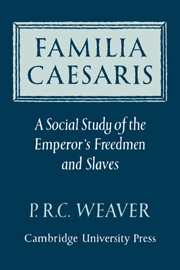Book contents
- Frontmatter
- Contents
- Preface
- Abbreviations
- INTRODUCTION
- PART I NOMENCLATURE AND CHRONOLOGY
- PART II THE FAMILY CIRCLE
- PART III THE EMPEROR'S SERVICE
- 12 Vicarii
- 13 Liberti servus and liberti libertus
- 14 ‘Vicariani’
- 15 The occupational hierarchy: some points of method
- 16 Sub-clerical grades
- 17 Adiutores: junior clerical grades
- 18 Intermediate clerical grades
- 19 Senior clerical grades
- 20 Senior administrative grades: a rationibus, ab epistulis, etc.
- 21 Freedman procurators
- 22 Imperial freedmen and equestrian status: the father of Claudius Etruscus
- CONCLUSION
- APPENDIXES
- Bibliography
- Index
16 - Sub-clerical grades
Published online by Cambridge University Press: 07 October 2011
- Frontmatter
- Contents
- Preface
- Abbreviations
- INTRODUCTION
- PART I NOMENCLATURE AND CHRONOLOGY
- PART II THE FAMILY CIRCLE
- PART III THE EMPEROR'S SERVICE
- 12 Vicarii
- 13 Liberti servus and liberti libertus
- 14 ‘Vicariani’
- 15 The occupational hierarchy: some points of method
- 16 Sub-clerical grades
- 17 Adiutores: junior clerical grades
- 18 Intermediate clerical grades
- 19 Senior clerical grades
- 20 Senior administrative grades: a rationibus, ab epistulis, etc.
- 21 Freedman procurators
- 22 Imperial freedmen and equestrian status: the father of Claudius Etruscus
- CONCLUSION
- APPENDIXES
- Bibliography
- Index
Summary
What were the posts which gave access to the promotion scale, and how were they recruited? In the first place one can rule out the sub-clerical workers – the non-clerical, non-financial, non-professional; for example, the pedisequi, custodes, nomenclatores, tabellarii, and most of the often-quoted specialists who served on the purely domestic staff of the Palace. A gap, or occupational discontinuity, opened between the sub-clerical and the clerical staff of the administration and it was rare indeed for anyone to jump it.
The age figures suggest this. Typical are those for the pedisequi (attendants), a dozen of whom died at ages evenly spread from 20 to 70. They are all slaves, and the high proportion – more than half – who were aged over 40 indicates an occupation unskilled and unremunerative, without prospects but perhaps not excessively strenuous, and congenial to the unambitious. One exception to the rule is instructive. A certain Eutychus, as a slave, was pedisequus a vinis – sub-clerical. He is found later as T. Aelius Aug. lib. Eutychus, still in the same department, as adiutor a vinis. That is to say, after some years as attendant in the department of the Imperial wine supply, in his thirties probably, and after manumission, he rose to the bottom rung on the clerical ladder, a grade usually occupied at the beginning of their careers while still slaves by those fortunate enough to be professional civil servants all their lives from their initial appointment in their late teens.
- Type
- Chapter
- Information
- Familia CaesarisA Social Study of the Emperor's Freedmen and Slaves, pp. 227 - 230Publisher: Cambridge University PressPrint publication year: 1972



